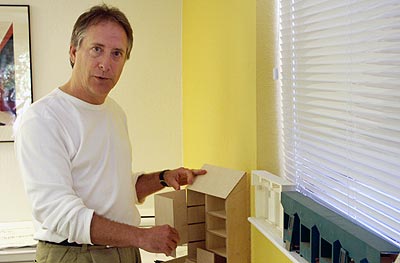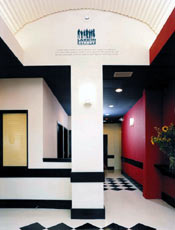|

|

|
NEWS SEARCH
|
|
|

|
EXTRAS
|
|
|

|
 |
| Sam
Davis shows off a model of a bed-cupboard unit he designed
for an adult homeless shelter. Photo by BAP |
Housing for the homeless: Q&A with Sam Davis, Berkeley professor
and affordable-housing architect
24 October 2002
By Bonnie Azab Powell, Public Affairs
BERKELEY - While "blockbuster" projects like
Frank Gehry's art museum in Bilbao, Spain, continue to rack
up magazine covers, architect and UC Berkeley professor Sam
Davis is concentrating on something much less glamorous: housing
for the homeless.
"A visit to a museum can be a powerful and moving experience.
Public buildings are a reflection of our culture," Davis
writes in his forthcoming book on the topic. "But if we
believe that architecture serves a society as well as reflects
its values, then we must use it to provide for those with the
most need and the fewest options."
On November 5, Californians will have the chance to vote on
whether society must in fact provide for that population. On
the ballot is the state's Proposition 46, or the Housing and
Emergency Shelter Trust Fund Act of 2002, is a $2.1 billion
bond measure to fund various affordable housing programs and
earmarks $15 million for low-income student housing. And in
San Francisco, Proposition N (Care Not Cash) seeks to curtail
the city's monthly cash allowance to homeless people and substitute
services, while Proposition O (Exits From Homelessness) would
require the city to add housing and addiction treatment programs
for the homeless by 2004.
It seemed the right time to sit down with Davis and learn more
about the issues involved in providing housing for the poor
and homeless, which Davis has been studying for most of his
career. The former chair of Berkeley 's architecture department
and a faculty member since 1971, he has taken the fall semester
off —with the help of a Guggenheim fellowship and a humanities
research fellowship — to research a new book on architecture
for the homeless. He has authored two previous books, The
Form of Housing and The Architecture of Affordable
Housing.
He also has practical experience with the subject. As the principal
of Sam Davis Architecture in Berkeley, he has collaborated with
other design firms and nonprofits on many homeless and affordable
housing projects, including the first-phase renovation of University
Village, UC Berkeley's married-student housing in Albany; a
100-bed homeless shelter in Contra Costa County; Larkin Street
Youth Services of San Francisco's facility for homeless youth
with HIV and AIDS; and most recently, the Lark-Inn — a
transitional shelter on San Francisco's Ellis Street for homeless
and runaway kids.
How is architecture for the homeless
different from designing affordable housing in general?
Well, what we call "affordable housing" means permanent
housing, and it's not unlike any other housing except that it's
aimed at people who can't compete in the marketplace. The lack
of affordable housing is one of the reasons among many that
people are homeless, so some housing for homeless should be
exactly that.
But there are also a lot of other things operating in homelessness
that require other types of living situations. Many people think
the homeless population is pretty much homogeneous, and it's
not. There are families with children, there are a lot of seniors,
also people who are mentally and physically ill, people with
substance abuses, and runaway kids. Each of those populations
has different programmatic housing and services needs.
| |
|
 |
| Lobby
of Larkin Street Youth Services' Assisted Care and Aftercare
facility on Hyde Street for homeless youth. Davis purposefully
used bright colors and dynamic patterns to make the center
feel friendly, not institutional. |
You've just finished a shelter
for homeless teenagers in San Francisco. What special needs
did that project have?
There were some interesting ones. Many homeless teens, runaway
girls in particular, have pets, and they won't go to shelters
unless they can bring their animals. So we included a kennel.
It hasn't been used that much: either our expectation was inaccurate
or else that group is still not willing to come to the shelter.
Another issue is that kids will not go to someplace they feel
is threatening or institutional. So we went out of our way to
make the center incredibly lively and colorful.
The design had to be flexible. The center is separated into
mini-dorms, because the staff wouldn't know from night to night
what the population would be: how many boys, how many girls,
how many people who would require more supervision. There's
also a "gateway" dorm in the back, one for boys and
one for girls, where the kids live as the last step before they
go to their own housing. It's more remote from supervision,
with its own bathrooms, and they can come and go as they please.
It doesn't have its own kitchen, however; there's one kitchen
for the center and everybody eats there. With homeless housing,
particularly for homeless kids, the kitchen is a really important
component. They’ve been out on the street and scrounging
or doing what they call "survivor sex" for meals.
Once they get into a stable environment like the shelter, we
wanted them to feel that food is not a crisis; they can have
it when they want with no hassle. They can just walk into the
kitchen, open the refrigerator, and pour a glass of juice or
help themselves to food. Also, the eating of a meal with other
people on a regular basis is an important aspect of the socialization
process.
How much of designing for the
homeless is about budget constraints, or finding low-cost building
materials?
That's a common misconception. Everybody thinks the way we're
going to provide more housing is to make it cheaper to build,
and that's impossible. If you go down to Truitt & White
and buy a 2x4 to put in the wall, it costs the same whether
I plan to put it in a luxury condo or in housing for the homeless.
The construction costs are a relatively minor component of a
project's total, not nearly as important as the cost of financing,
the cost of land, the soft costs and the political costs.
Some finishes and materials will be cheaper than others, sure.
But if you put cheap materials in a environment where there's
a constant turnover, where the people coming in are sick or
angry, they'll last ten minutes. That's not cost-effective either.
So is there anything that can be done to bring costs
down and get more affordable units built?
That's a long discussion. One basic issue is the need to balance
repetition — which saves money — with architectural
interest. The more elements are repeated, such as structural
frames, bathrooms, kitchens, cabinets, etc., the more you save.
If you focus only on that, however, you will get the type of
public housing nobody likes. The challenge is to use architectural
gestures where they have the most impact, like bay windows and
covered entries. They don't add much to the cost, but they do
add much to variety and function.
Can recently homeless residents
be integrated into mainstream housing, or do they need to be
housed separately with their own social services?
They need to be near social services, and the trend these days
is to make housing specifically for them. But I think it can
and should be an integral part of the community: whether other
people live in the same building, say, would depend on the extent
of mental illness in the formerly homeless residents. Regardless,
it's important that we not isolate people who have been homeless,
because part of the homelessness syndrome is that they become
totally separated from social systems.
New York and Chicago have demolished
much of their public housing projects, built from the 1940s
to the '70s, that clustered people in high-density towers. Why
didn't such projects work?
Well, that's a whole other book. First of all, it wasn't fitting
for the types of people who were going to live there, most of
whom were families with children. It removed the children from
any play areas as well as removed most of the people from any
kind of observable, controllable, and secure outdoor space.
It didn't have any of the kind of transitions from public to
private space that we associate with other kinds of housing.
It just wasn't a good programmatic match for the people who
were going to live there.
This country is very ambivalent about helping the poor. And
so when we get around to doing it, we think it should be the
minimal. And that's what we built for them: the minimal.
All of your projects seem to be
low-rise, freestanding units. What benefits does that approach
offer?
The fact is, most people in this country want to live in a single-family
detached house. That's been reinforced by tax policy, planning
policy, and by other kinds of government incentives like the
G.I. Bill. It's more than just the American dream, it's the
American expectation. Given that context, anybody who lives
in something else is seen as a kind of second-class citizen.
My view has always been that the goal of affordable housing
should be to supply as many of the amenities of the single-family
house as you can, even if you have to increase density (number
of units per acre). So the housing that we and many other affordable
housing architects design tries to include private space immediately
adjacent to the public areas, with transitional space in between,
and a semi-public space like a central courtyard that's controllable
and viewable.
With University Village in Albany, we tried to make it feel
like they were sets of individual houses. You don't want to
detach people from the ground, you want them to be able to know
their neighbors, you want to make space that's viewable just
like you would in any other neighborhood. We went out of our
way to make sure every single apartment there has its own front
door. They don't share a vestibule or a corridor, every resident
has their own address and front door.
You've been teaching classes on
affordable design for years to graduate and undergraduate students.
What kind of an attitude do you try and instill in them?
| |
|
 |
'The
fact is, most people in this country want to live in a single-family
detached house ... It's more than just the American dream,
it's the American expectation.
—Sam Davis, UC Berkeley architecture professor
|
First, I think that part of the responsibility of teaching
at a university, particularly at a public one, is that you have
to deal with social issues. One could say that every kind of
architecture has social implications, and that's probably true.
But I've always felt that housing, among all the kinds of buildings,
has the most social context and requires the greater sense of
social responsibility.
I try to teach my students to pay attention to who's going to
live there. They have to try to understand what those people's
needs, ambitions and desires are, and balance them with other
things like the community context and the budget. That should
be true for all architecture, but with housing, architects often
think that if they themselves like it and would live there,
that's enough. And it's not.
There's also the little things that people think you can dispense
with in affordable housing. When you walk through the front
door, are you all of a sudden in the middle of the room? Again,
it's about transitions. Whenever we come home, we're carrying
stuff. We've got keys, we're fumbling around, it might be raining.
We need a transition to the living space. It's little gestures
like that that make all the difference as to how habitable a
design is going to be.
The Bay Area's homeless population
is estimated at 10,000 to 15,000, one of the highest in the
nation. Why do you think that is?
The biggest reason for the number of homeless
here, I think, is that we have an incredibly expensive housing
market all over the Bay Area, and we've seen a lot of gentrification,
like in San Francisco's South of Market district, that have
priced poor people out of the neighborhood.
San Francisco is probably more tolerant than most places of all
kinds of lifestyles, so I do think that's been a contributing
factor. But my experience is that most people don't want to be
homeless. Some traumatic thing happened in their life that pushed
them into this, or they just don't have the wherewithal to operate
as a healthy, totally socialized human being: they can't hold
a bank account, get credit, pay first and last month's rent, or
manage their money, or they're ill in some way. And if you found
housing for them, they would probably be better than they are
now.
Some people argue that the city
is too easy on its homeless.
If you read the newspapers, then maybe you get that impression,
and certainly I think some of San Francisco's propositions reinforce
that idea — the current notion that if you take away the
$350 a month, fewer people will come here and the ones that
are already here will seek services.
The city does offer plenty of social services, but they’re
not very well coordinated. One hand doesn't know what the other
is doing. They've just started this computerized tracking system
where you go in and give your name and it will tell what services
you've accessed before and direct you to the right place, hopefully.
The Homeless Coalition is really against it, but I think it
could have a positive effect.
There
is a cost to society for devoting tax dollars to housing the
homeless. What is the benefit?
Society itself benefits from well-designed places for the homeless.
First, we're spending millions to hide the homeless and clean
up after them. This money could be put to better use with more
and better facilities, which would have the added benefit of
helping those who assist the homeless. Many shelter staff have
been homeless themselves and work long hours often in stressful
and difficult jobs. They encounter people in distress —
often sick, sometimes violent, some with small children —
and they help them. They are remarkably generous people who
receive less than generous pay. They deserve to work in an environment
that makes their job easier and that helps them in their mission.
Second,
when we create good facilities, not only do we remove people
from the street, but we integrate them into the community. Cities
are places of diversity and choice: that's what makes them interesting
and exciting. By accommodating different populations with suitable
places, we strengthen communities.
More
information:
|

|